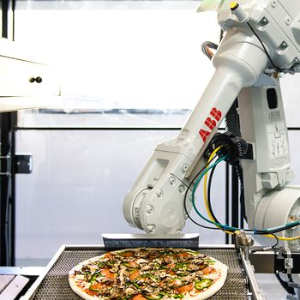There has recently been a big to-do about robotics in the resto business – in the kitchen and for order handling. Fast Food chains say AI and robotics are essential for their survival in the face of higher staff wages and food costs. Employees are upset…
 Flippy 2: Fully automated fry maker by Miso Robotics, installed at a White Castle location.
Flippy 2: Fully automated fry maker by Miso Robotics, installed at a White Castle location.
The latest chapter in the ongoing battle of human staffers vs. the ‘business model of the future’ in the Fast Food sector has thrown gasoline on an old fire. Not to mention salting an old wound.
The State of California last month had passed legislation that could see Fast Food workers receive wage increase from an average of around $8 to as high as $22 an hour. That’s great for the workers, and could quell chronic complains of inadequate pay for a time. But the grab-and-go resto sector there is panicking.
Things already tough for Fast Food operators
Fast food operators everywhere experienced their most unstable business environment ever during the COVID pandemic. But on the plus side, they were forced to consider updating their business model to survive into the future. However… All the major players subsequently developed new ‘resto of the future’ concepts playing down human staff, in-store seating and counter service. At the same time, the new concepts play up non-contact ordering and fulfillment, and optimize smaller building lots for delivery, drive-thru and walk-up operations.
Along with that, kitchen staffing is being ‘streamlined (minimized). And AI and robotics are proliferating to prep, portion and assemble orders.
Enter, unionization?
And a dimension that had been threatened before by workers, but is really taking hold now, is making resto operators even more nervous: unionization.
That’s a potential double whammy to resto owners, who still need some humans in their operating plans. Dramatically higher wages are now the law in Cali, and unionization is the workers’ right, if they can get themselves organized.
Numbers tell the tale
A Gallup Poll of Americans a year ago last month indicated that general support for unions had increased steadily since 1965. Although the 2021 poll showed that:
- At 9 percent, U.S. adults’ self-reported membership in a labor union fell within the 7 to 12 percent range it has occupied over the past 20 years.
- Another 8 percent of Americans live in a household with a union member, meaning…
- A total of 17 percent of Americans reside in a ‘union household’… and
- A big majority of 83 percent of households do not include any union members.
But if you add in all the Fast Food workers who could be unionized over the next few years, those numbers change dramatically.
My take
No actual figures have been attached to the ‘resto of the future’ concept development. But the new automated model is already being rolled out and phased all across the land. Looks like the revolution is here, no matter what the nay-sayers have to say.
As I’ve pointed out before, when talk of higher wages for Fast Food employees has come up, the profile of burger slingers has changed markedly wince the millennium:
- Fast Food used to appeal to kids looking for a first ‘real’ job, or older folks wanting a flex-hours second income to augment their pensions and benefits.
- Now, more older ‘younger generation’ folks are relying on Fast Food jobs as their primary source of income. That’s where the calls for big wage hikes are coming from.
- McDonald’s, for one, has underlined the former position, saying it was proud to have given millions of teens their first jobs instilling a sense of responsibility and work ethics in successive generations. At the same time, they have said they were proud to employ pensioners and other older folks, creating a new job classification that has since spread to the big department stores (eg.- Walmart) and other sectors.
- At the same time, McDonald’s emphasized that it never intended its original business model to provide a ‘primary’, or ‘living wage’ to any single-member household or family. (Except for its adult supervisors; managers, franchisees, etc.)
The other side of the coin seems to beg two big questions:
- Would Fast Food fans stand for menu price increases that could mean Big Mag Macs or Whoppers selling for $12 to $15 by the end of this year?
- Would strict enforcement of the new California Fast Food wage scale lead to the demise of all or at least a significant number of the traditional players in the fast Food Sector as a result of sales erosion?
On the other hand:
Would disaster for the Fast Food sector be a huge opportunity for the growing Street Food sector, almost universally run by independent owner-operators?
Muse on that…
~ Maggie J.

